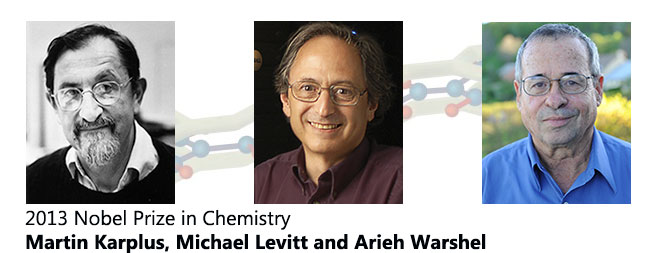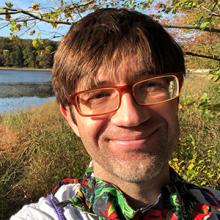3 Share Nobel Prize for Theoretical Chemistry Discoveries

Background image © The Royal Swedish Academy of Sciences http://www.nobelprize.org | Karplus image via Michigan State University | Levitt and Warshel images via Wikimedia Commons |composite image by Lalena Lancaster
(Inside Science) -- The 2013 Nobel Prize in chemistry has been awarded to three theoretical chemists for research combining quantum mechanics and classical mechanics to model chemical reactions.
The prize goes jointly to Martin Karplus, 83, from the University of Strasbourg, in France, and Harvard University, Michael Levitt, 66, from Stanford University, and Arieh Warshel, 72, from the University of Southern California, "for the development of multiscale models for complex chemical systems."
All three scientists were born outside the United States but hold citizenship in the U.S., as well at least one other country: Karplus was born in Austria, Levitt in South Africa, and Warshel in Israel.
The three winners worked at many different institutions and overlapped at multiple research centers, including Karplus' lab at Harvard, and the Weizmann Institute of Science in Israel, where they developed computer models of molecules and chemical reactions. Such models can be quite complicated and computation-intensive, but good ones can make it easier to understand reactions that happen in photosynthesis, solar cells, drug interactions, and more.
Karplus, Levitt, and Warshel developed new insights by combining 17th century classical mechanics, which, for example, describes what happens when a bat hits a ball, with 20th century quantum mechanics, which describes the often strange and non-intuitive behavior of matter at sub-microscopic scales. Classical mechanics are more general and more applicable to phenomena that occur at visible scales, whereas quantum mechanics governs the behavior of atoms and molecules and their constituent particles, such as electrons.
"In the 1970s this was very courageous work," said Gregory A. Voth, a professor of chemistry at the University of Chicago, who researches what he calls the next generation of simulations, building upon the work of the three new laureates.
Simulating chemical reactions is complicated and modeling complex molecules requires extensive computer power. The three winners found a hybrid approach to use quantum mechanics to describe the often small fraction of a large molecule that is directly involved in a reaction, and then classical mechanics to simulate the behavior of the remainder of the molecule.
This is especially applicable to enzymes and proteins, which can contain tens of thousands of atoms per molecule.
"[W]hat is needed is a way to find quantum mechanics and classic mechanics to shake hands; as simple as that," said Nobel committee member Sven Lidin, during the news conference announcing the award.
High school chemistry students are familiar with models of molecules built of sticks and Styrofoam balls, and that's how chemists built them for a long time, but the proliferation of computers offered a chance to further improve scientists' understanding of chemical reactions. Karplus, Levitt, and Warshel took chemistry experiments to cyberspace, said Staffan Normark, permanent secretary of the Royal Swedish Academy of Sciences, in his comments introducing the prize.
In 1972, Karplus and Warshel produced a model -- the first to combine classical and quantum mechanics in a useful way -- of the chemical reaction that occurs between retinal, a molecule crucial to human vision, and one form of vitamin A. When light strikes the retina, retinal responds, as its free electrons surge with energy and change the molecule's shape.
This model was a breakthrough, but could only be applied to a limited number of reactions.
Levitt and Warshel then developed a more advanced model in 1976, which could be used for any size of reaction.
According to a statement from Stanford, Levitt's first computer contained less than one megabyte of memory, over 16,000 times less than the latest model of the iPhone. Even today, modeling the behavior of entire large molecules using quantum mechanics principles is too computationally intense to provide practical insights. For that reason, theoretical chemists today still use the framework developed in the 1970s by Karplus, Levitt, and Warshel. Modeling each electron and atomic nucleus in large molecular reactions remains too complicated, despite the nearly inconceivable advances in computer technology.
Computers are useful because they illuminate what the eye can't see. Some chemical reactions happen so fast -- fractions of a millisecond -- they cannot be observed during an experiment. The Nobel winners' insight to use quantum mechanics to model the few atoms directly involved in a reaction, and to use classical mechanics to understand what happens to the rest of the molecules, allows scientists to gather insights from the computer, and then go back to the lab bench to confirm the details, in many cases.
"The ability to simulate accurately chemical processes is now every bit as important as laboratory experiments, at least in the world of chemistry and I would argue molecular biology also," said Voth. "More than anything, [the prize] recognizes a transformation of the field where computing in general is on par with experiment."

